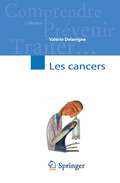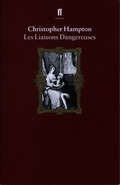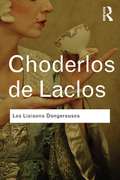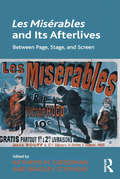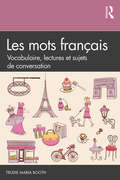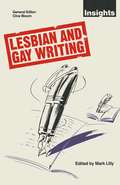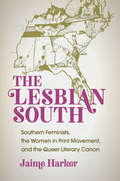- Table View
- List View
Leopardi and Shelley: Discovery, Translation and Reception
by Cerimonia DanielaGiacomo Leopardi (1798-1837) and Percy Bysshe Shelley (1792-1822) crossed paths during their lifetimes, and though they never met, the legacy of their work betrays a shared destiny. As prominent figures who challenged and contributed to the Romantic debate, Leopardi and Shelley hold important roles in the history of their respective national literatures, but paradoxically experienced a controversial and delayed reception outside their native lands. Cerimonia‘s wide-ranging study brings together these two poets for the first time for an exploration of their afterlives, through a close reading of hitherto unstudied translations. This intriguing journey tells the story, from its origins, of the two poets critical fortune, and examines their position in the cultural debates of the nineteenth century; in disputes regarding translation theories and practices; and shows the configuration of their identities as we understand their legacy today.
Leopardi and Shelley: Discovery, Translation and Reception
by Cerimonia DanielaGiacomo Leopardi (1798-1837) and Percy Bysshe Shelley (1792-1822) crossed paths during their lifetimes, and though they never met, the legacy of their work betrays a shared destiny. As prominent figures who challenged and contributed to the Romantic debate, Leopardi and Shelley hold important roles in the history of their respective national literatures, but paradoxically experienced a controversial and delayed reception outside their native lands. Cerimonia‘s wide-ranging study brings together these two poets for the first time for an exploration of their afterlives, through a close reading of hitherto unstudied translations. This intriguing journey tells the story, from its origins, of the two poets critical fortune, and examines their position in the cultural debates of the nineteenth century; in disputes regarding translation theories and practices; and shows the configuration of their identities as we understand their legacy today.
Leopardi's Nymphs: Grace, Melancholy, and the Uncanny
by Fabio A. Camilletti"How can one make poetry in a disenchanted age? For Giacomo Leopardi (1798-1837) this was the modern subject's most insolvable deadlock, after the Enlightenment's pitiless unveiling of truth. Still, in the poems written in 1828-29 between Pisa and the Marches, Leopardi manages to turn disillusion into a powerful source of inspiration, through an unprecedented balance between poetic lightness and philosophical density. The addressees of these cantos are two prematurely dead maidens bearing names of nymphs, and thus obliquely metamorphosed into the charmingly disquieting deities that in Greek lore brought knowledge and poetic speech through possession. The nymph, Camilletti argues, can be seen as the inspirational power allowing the utterance of a new kind of poetry, bridging antiquity and modernity, illusion and disenchantment, life and death. By reading Leopardi's poems in the light of Freudian psychoanalysis and of Aby Warburg's and Walter Benjamin's thought, Camilletti gives a groundbreaking interpretation of the way Leopardi negotiates the original fracture between poetry and philosophy that characterises Western culture. Fabio Camilletti is Assistant Professor in Italian at the University of Warwick."
Leopardi's Nymphs: Grace, Melancholy, and the Uncanny
by Fabio A. Camilletti"How can one make poetry in a disenchanted age? For Giacomo Leopardi (1798-1837) this was the modern subject's most insolvable deadlock, after the Enlightenment's pitiless unveiling of truth. Still, in the poems written in 1828-29 between Pisa and the Marches, Leopardi manages to turn disillusion into a powerful source of inspiration, through an unprecedented balance between poetic lightness and philosophical density. The addressees of these cantos are two prematurely dead maidens bearing names of nymphs, and thus obliquely metamorphosed into the charmingly disquieting deities that in Greek lore brought knowledge and poetic speech through possession. The nymph, Camilletti argues, can be seen as the inspirational power allowing the utterance of a new kind of poetry, bridging antiquity and modernity, illusion and disenchantment, life and death. By reading Leopardi's poems in the light of Freudian psychoanalysis and of Aby Warburg's and Walter Benjamin's thought, Camilletti gives a groundbreaking interpretation of the way Leopardi negotiates the original fracture between poetry and philosophy that characterises Western culture. Fabio Camilletti is Assistant Professor in Italian at the University of Warwick."
Lernen als soziale Praxis im Internet: Objektiv hermeneutische Rekonstruktionen aus einem Forum zum Videospiel Pokémon
by André CzaudernaAndré Czauderna beschäftigt sich mit Lernprozessen im Internet am Beispiel eines Forums zum Videospiel Pokémon. In vier objektiv hermeneutischen Sequenzanalysen rekonstruiert er die Strukturmerkmale, die den Prozess des Lernens – verstanden als soziale Praxis – im Rahmen der untersuchten Threads charakterisieren. Schließlich skizziert er die Grundzüge einer soziologischen Theorie des Lernens in Computerspielinternetforen.
Lernstile im interkulturellen Kontext: Eine empirische Untersuchung am Beispiel von Deutschland und China
by Xun LuoDie BeiträgerInnen des vorliegenden Sammelbandes setzen sich mit unterschiedlichen Spannungsfeldern und Widersprüchen des Themas Risiko und Soziale Arbeit auseinander. Dabei vermischen sich strukturelle Risikofaktoren mit individuellen Gefährdungslagen, politische Unwägbarkeiten mit einer oft sozialarbeitskritischen Öffentlichkeit, Wünsche nach professioneller und organisationaler Absicherung mit persönlicher Risikobereitschaft und (post)heroischem Risikomanagement.
Les cancers (Comprendre, prévenir, traiter)
by Valérie Delavigne« Au début, elle est minuscule. Un truc ridicule. Un rien. Une toute petite chose. Mais qui va faire de si grands dégâts… ». De quoi s’agit-il ? De cellules cancéreuses. Voici un livre qui raconte, dans un style alerte et de façon claire et imagée, comment elles se développent, les divers outils pour les découvrir et tenter de les éradiquer, comment mieux vivre la maladie... Ce livre s’adresse aux personnes atteintes de cancer, à leur entourage, aux experts, médecins, infirmières ou membres des équipes soignantes qui souhaiteraient trouver des mots pour expliquer le cancer, ses origines, son diagnostic, ses traitements, ainsi que des informations complètes et fiables sur le cancer. Docteur en sciences du langage, Valérie Delavigne travaille depuis de nombreuses années sur la vulgarisation scientifique et technique. Consultante et formatrice, elle participe à divers projets de recherche et collabore à la rédaction de brochures destinées aux patients atteints de cancer et à leurs proches.
LES CONTEMPLATIONS of Victor Hugo: An Allegory of the Creative Process
by Suzanne NashVictor Hugo's work presents the reader with a paradox nowhere more apparent than in the collection of more than 150 lyric poems entitled Les Contemplations. Although he insisted upon structural unity, his complex artistic creations often seem disordered and digressive. Suzanne Nash examines this contradiction, and she proposes here a new approach to Les Contemplations that reveals how it may be read as a unified allegory of Hugo's understanding of the creative process.The author's reading heightens the subtleties of individual poems by placing them within the context of the collection. She clarifies the poet's use of rhetorical devices and. illuminating Les Contemplations as a metapoetic creation, shows how it can serve as a guide to Hugo's other works. The first two chapters present evidence of Hugo's narrative intention, place his work within an allegorical tradition, and describe the structure of the allegory. One poem, Pasteurs et troupeaux, is analyzed as a paradigm for the whole, and a single theme, that of Léopoldine as sacrificial muse and figure for poetic language, is traced through the six books. The author demonstrates Hugo's narrative purpose in his use of rhetorical forms and examines (according to predominance of themes, images, and technical devices) the six chapters as steps in the religio-poetic allegory.Originally published in 1977.The Princeton Legacy Library uses the latest print-on-demand technology to again make available previously out-of-print books from the distinguished backlist of Princeton University Press. These editions preserve the original texts of these important books while presenting them in durable paperback and hardcover editions. The goal of the Princeton Legacy Library is to vastly increase access to the rich scholarly heritage found in the thousands of books published by Princeton University Press since its founding in 1905.
Les Liaisons Dangereuses
by Christopher HamptonThe scandalous reputation of Laclos's novel, first published in 1782, is based on its chilling portrayal of the mannered decadence and sexual cynicism of the French aristocracy in the last years of the ancien regime. Christopher Hampton has made a masterful adaptation for the stage of the conspiracy to corrupt a young girl barely out of her convent.Les liaisons dangereuses was premiered by Royal Shakespeare Company at The Other Place, Stratford-upon-Avon, on 24 September 1985, and won Christopher Hampton the Evening Standard Award for Best Play and the Laurence Olivier Award for Best New Play in 1986.
Les Liaisons Dangereuses
by Choderlos De LaclosOne of the most `modern' of eighteenth-century novels, Les Liasons Dangereuses is the brilliantly observed and vividly rendered story of two libertines and the innocent characters they plot to destroy.
Les Liaisons Dangereuses
by Pierre Choderlos de Laclos‘I resolved to write a book which would create some stir in the world and continue to do after I had gone from it.’ - Choderlos de Laclos A great sensation at the time of first publication, Les Liaisons Dangereuses reads as much the most 'modern' of eighteenth-century novels. Viewed by some critics as a morality tale and others as a subtle inquiry into libertinism, it brilliantly depicts the foibles of the French aristocracy on the eve of the French Revolution. Renowned for its exploration of lust, revenge and human malice, and still carrying a tremendous power to shock, its adaptations for screen and stage have made its central characters notorious for their sophisticated and ultimately tragic games of seduction and manipulation.
Les Liaisons Dangereuses
by Pierre Choderlos de Laclos‘I resolved to write a book which would create some stir in the world and continue to do after I had gone from it.’ - Choderlos de Laclos A great sensation at the time of first publication, Les Liaisons Dangereuses reads as much the most 'modern' of eighteenth-century novels. Viewed by some critics as a morality tale and others as a subtle inquiry into libertinism, it brilliantly depicts the foibles of the French aristocracy on the eve of the French Revolution. Renowned for its exploration of lust, revenge and human malice, and still carrying a tremendous power to shock, its adaptations for screen and stage have made its central characters notorious for their sophisticated and ultimately tragic games of seduction and manipulation.
Les Misérables and Its Afterlives: Between Page, Stage, and Screen
by Kathryn M. Grossman Bradley StephensExploring the enduring popularity of Victor Hugo’s Les Misérables, this collection offers analysis of both the novel itself and its adaptations. In spite of a mixed response from critics, Les Misérables instantly became a global bestseller. Since its successful publication over 150 years ago, it has traveled across different countries, cultures, and media, giving rise to more than 60 international film and television variations, numerous radio dramatizations, animated versions, comics, and stage plays. Most famously, it has inspired the world's longest running musical, which itself has generated a wealth of fan-made and online content. Whatever its form, Hugo’s tale of social injustice and personal redemption continues to permeate the popular imagination. This volume draws together essays from across a variety of fields, combining readings of Les Misérables with reflections on some of its multimedia afterlives, including musical theater and film from the silent period to today's digital platforms. The contributors offer new insights into the development and reception of Hugo's celebrated classic, deepening our understanding of the novel as a work that unites social commentary with artistic vision and raising important questions about the cultural practice of adaptation.
Les Misérables and Its Afterlives: Between Page, Stage, and Screen
by Kathryn M. Grossman Bradley StephensExploring the enduring popularity of Victor Hugo’s Les Misérables, this collection offers analysis of both the novel itself and its adaptations. In spite of a mixed response from critics, Les Misérables instantly became a global bestseller. Since its successful publication over 150 years ago, it has traveled across different countries, cultures, and media, giving rise to more than 60 international film and television variations, numerous radio dramatizations, animated versions, comics, and stage plays. Most famously, it has inspired the world's longest running musical, which itself has generated a wealth of fan-made and online content. Whatever its form, Hugo’s tale of social injustice and personal redemption continues to permeate the popular imagination. This volume draws together essays from across a variety of fields, combining readings of Les Misérables with reflections on some of its multimedia afterlives, including musical theater and film from the silent period to today's digital platforms. The contributors offer new insights into the development and reception of Hugo's celebrated classic, deepening our understanding of the novel as a work that unites social commentary with artistic vision and raising important questions about the cultural practice of adaptation.
Les mots français: Vocabulaire, lectures et sujets de conversation
by Trudie Maria BoothLes mots français: Vocabulaire, lectures et sujets de conversation presents a clear, thorough and systematic overview of modern French vocabulary on a variety of subjects. Written in the target language, each of the 32 chapters is divided into the following sections, with translations into English to facilitate the learning process: • basic vocabulary (vocabulaire de base) • additional vocabulary (vocabulaire supplémentaire) • related vocabulary (vocabulaire apparenté) • idiomatic expressions, sayings and proverbs (proverbes et expressions) • cultural readings (lectures). The book includes a range of communicative exercises and sample sentences, while an answer key and flashcards are available online. This is essential reading for learners at level A2–C2 of the Common European Framework for Languages, and Intermediate Mid–Advanced on the ACTFL proficiency scales.
Les mots français: Vocabulaire, lectures et sujets de conversation
by Trudie Maria BoothLes mots français: Vocabulaire, lectures et sujets de conversation presents a clear, thorough and systematic overview of modern French vocabulary on a variety of subjects. Written in the target language, each of the 32 chapters is divided into the following sections, with translations into English to facilitate the learning process: • basic vocabulary (vocabulaire de base) • additional vocabulary (vocabulaire supplémentaire) • related vocabulary (vocabulaire apparenté) • idiomatic expressions, sayings and proverbs (proverbes et expressions) • cultural readings (lectures). The book includes a range of communicative exercises and sample sentences, while an answer key and flashcards are available online. This is essential reading for learners at level A2–C2 of the Common European Framework for Languages, and Intermediate Mid–Advanced on the ACTFL proficiency scales.
Lesbian and Gay Writing (Insights)
by Mark LillyPart of a series which looks at contemporary criticism on neglected literary and cultural areas, this book examines the conventional academic view of lesbian/gay writing and has essays on lesbian writers as well as a section on gay men's writing. All the critical essays are by lesbians or gay men.
Lesbian Discourses: Images of a Community (Routledge Studies in Linguistics)
by Veronika KollerLesbian Discourses is the first book-length treatment of lesbian text and discourse. It looks at what changing images of community American and British lesbian authors have communicated since 1970, how this change can be traced in texts such as pamphlets, magazines and blogs, and why this change has taken place. At the heart of the book is a detailed linguistic analysis, which is embedded in a discussion of the relevant socio-political contexts and discourse practices, and supplemented by interview data. The book can more generally be read as an example of how to do textual analysis in social research, in particular how to engage in the discourse-historical and socio-cognitive study of collective identity. Despite its text-centered approach, the book avoids being overly technical and will therefore be of interest not only to postgraduate students and researchers in linguistics but also to those in anthropology, history and sociology, especially women’s/gender studies.
Lesbian Discourses: Images of a Community (Routledge Studies in Linguistics)
by Veronika KollerLesbian Discourses is the first book-length treatment of lesbian text and discourse. It looks at what changing images of community American and British lesbian authors have communicated since 1970, how this change can be traced in texts such as pamphlets, magazines and blogs, and why this change has taken place. At the heart of the book is a detailed linguistic analysis, which is embedded in a discussion of the relevant socio-political contexts and discourse practices, and supplemented by interview data. The book can more generally be read as an example of how to do textual analysis in social research, in particular how to engage in the discourse-historical and socio-cognitive study of collective identity. Despite its text-centered approach, the book avoids being overly technical and will therefore be of interest not only to postgraduate students and researchers in linguistics but also to those in anthropology, history and sociology, especially women’s/gender studies.
The Lesbian Lyre: Reclaiming Sappho for the 21st Century
by Jeffrey M. DubanHailed by Plato as the “Tenth Muse” of ancient Greek poetry, Sappho is inarguably antiquity’s greatest lyric poet. Born over 2,600 years ago on the Greek island of Lesbos, and writing amorously of women and men alike, she is the namesake lesbian. What’s left of her writing, and what we know of her, is fragmentary. Shrouded in mystery, she is nonetheless repeatedly translated and discussed – no, appropriated – by all. Sappho has most recently undergone a variety of treatments by agenda-driven scholars and so-called poet-translators with little or no knowledge of Greek. Classicist-translator Jeffrey Duban debunks the postmodernist scholarship by which Sappho is interpreted today and offers translations reflecting the charm and elegant simplicity of the originals.Duban provides a reader-friendly overview of Sappho’s times and themes, exploring her eroticism and Greek homosexuality overall. He introduces us to Sappho’s highly cultured island home, to its lyre-accompanied musical legends, and to the fabled beauty of Lesbian women. Not least, he emphasizes the proximity of Lesbos to Troy, making the translation and enjoyment of Homer’s Iliad and Odyssey a further focus.More than anything else, argues Duban, it is free verse and its rampant legacy – and no two persons more than Walt Whitman and Ezra Pound – that bear responsibility for the ruin of today’s classics in translation, to say nothing of poetry in the twentieth century. Beyond matters of reflection for classicists, Duban provides a far-ranging beginner’s guide to classical literature, with forays into Spenser and Milton, and into the colonial impulse of Virgil, Spenser, and the West at large.
The Lesbian Muse and Poetic Identity, 1889–1930 (Gender and Genre)
by Sarah ParkerThroughout history the poetic muse has tended to be (a passive) female and the poet male. This dynamic caused problems for late Victorian and twentieth-century women poets; how could the muse be reclaimed and moved on from the passive role of old? Parker looks at fin-de-siècle and modernist lyric poets to investigate how they overcame these challenges and identifies three key strategies: the reconfiguring of the muse as a contemporary instead of a historical/mythological figure; the muse as a male figure; and an interchangeable poet/muse relationship, granting agency to both.
The Lesbian Muse and Poetic Identity, 1889–1930 (Gender and Genre #12)
by Sarah ParkerThroughout history the poetic muse has tended to be (a passive) female and the poet male. This dynamic caused problems for late Victorian and twentieth-century women poets; how could the muse be reclaimed and moved on from the passive role of old? Parker looks at fin-de-siècle and modernist lyric poets to investigate how they overcame these challenges and identifies three key strategies: the reconfiguring of the muse as a contemporary instead of a historical/mythological figure; the muse as a male figure; and an interchangeable poet/muse relationship, granting agency to both.
The Lesbian Premodern (The New Middle Ages)
by Noreen Giffney Michelle M. Sauer Diane WattKey scholars in the field of lesbian and sexuality studies take part in an innovative conversation that offers a radical new methodology for writing lesbian history and geography, drawing new conclusions on the important and often overlooked work being done on female same-sex desire and identity in relation to premodern cultures.
The Lesbian South: Southern Feminists, the Women in Print Movement, and the Queer Literary Canon
by Jaime HarkerIn this book, Jaime Harker uncovers a largely forgotten literary renaissance in southern letters. Anchored by a constellation of southern women, the Women in Print movement grew from the queer union of women's liberation, civil rights activism, gay liberation, and print culture. Broadly influential from the 1970s through the 1990s, the Women in Print movement created a network of writers, publishers, bookstores, and readers that fostered a remarkable array of literature. With the freedom that the Women in Print movement inspired, southern lesbian feminists remade southernness as a site of intersectional radicalism, transgressive sexuality, and liberatory space. Including in her study well-known authors—like Dorothy Allison and Alice Walker—as well as overlooked writers, publishers, and editors, Harker reconfigures the southern literary canon and the feminist canon, challenging histories of feminism and queer studies to include the south in a formative role.





